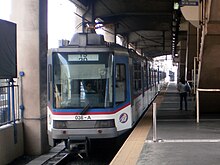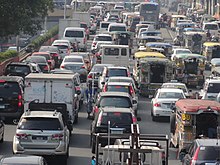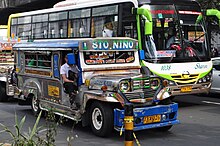Traffic in Metro Manila, based on the 2015 Global Satisfaction conducted by Waze, Metro Manila has the "worst traffic on Southeast Asia". Based on the 2015 Census of population by the Philippine Statistics Authority, the highly urbanized cities of Metro Manila were listed as being some of the densest cities in the world.[1]
Emerson Carlos, MMDA assistant general manager for operation, mentioned that in 2015, the total motor vehicles registered in Metro Manila have already peaked at 2.5 million.[2]
Causes[edit]
Infrastructure problems[edit]
One of the primary causes of traffic density within Metro Manila is the current transportation infrastructure. Overall, there is a lack of quality infrastructure thus insufficient modes of mobility. The Duterte administration has promised that the coming years will be the, " 'golden age of infrastructure',[3] with a record $168 billion to be spent on 5,000 projects across the nation”.[3]
Road network[edit]
The road network of Metro Manila consists of radial (R-1 to R-10) and circumferential (C-1 to C-5) roads. These are the principal arteries within the city, however given the density of vehicles within the metropolis the roads have become inadequate. "Metro Manila only has 1 km of road per 424 vehicles."[4]
Furthermore, the roads are of poor quality and do not receive maintenance. For example, in the scope of the entire country, "Of the 31,400 km of national roads in the system, only about 45% (14,200 km) were assessed as being in good or fair condition in November 2011.”[5] The poor quality of roads has made road-transportation inefficient. Furthermore, this has contributed to the increase in road accidents, which therefore affects both traffic congestion and public health.
The railway system[edit]
The current railways carry around 1.3 million passengers per day and spans 79 km in 4 different lines.[4] In 1998, plans for a railway expansion were implemented however only 5 km of the planned 73 km was actually built. As such, there exists a lack of an adequate non-road-based public transportation system.[4] This is made evident with the problem of overcrowding during peak hours.
Road-based Public Transport[edit]
In Metro Manila, there exists a variety of road-based public transport, such as tricycles, taxis, buses, and jeepneys which are all privately owned. While there is such a prevalence of these modes of transportation, these "account for more than 50% of daily commuting trips, incur no subsidy, and with low productivity.”[4] Meanwhile, "car travel accounts for 30% of person-km, but constitutes 72% of the road traffic in terms of PCU-km.”[4] The high number of vehicles on the road, which could be attributed to the high population, is one of the contributors to traffic congestion.
Urban planning problems[edit]
The layout of Metro Manila lacks holistic and intrinsic planning from the ground up.[6] The poor design did not account for the density of the city or the eventual propensity to vehicles. A classic example is the facts that the city hosts more vehicles than the roads could afford. Furthermore, laws and policies that are meant to mitigate such poor design are not enforced properly.
Urban area expansion[edit]
The urban area of Metro Manila experiences a high growth rate in population. Within the period of 2000-2001, the city experienced a rate of 1.8%.[4]This growth rate is a result of spillover of people from nearby towns, cities, and provinces. As the main hub of the Philippines, the influx of people is foreseeable yet the city has not taken such into account. Thus, the urban planning of the city is not adequate vis a vis the high population density. Statistics show that the city must "accommodate about an additional two million to six million by 2030.”[4] Thus, if such trend continues, 224 persons per hectare is estimated. This high population thus calls for an appropriate transportation system to allow for mobility within the city.
Traffic congestion[edit]
"Today, traffic demand is at 12.8 million trips in Metro Manila. Most of these trips are made using the public transport owing to its 69% share of total trips. The lesser share of the trips is done by private mode and yet it is this mode that takes up 78% of road space.”[4] At the current state, the traffic volume within the metropolis already exceeds the capacities of existing roads. The urban planning failed to bring into fruition a public transport system that could function in the dense, compact city of Metro Manila.
Economic theories[edit]
The Roadmap for Transport Infrastructure for Metro Manila and its Surrounding Areas (Region III & Region IV-A) study by the Japan International Cooperation Agency (JICA) in response to the National Economic Development (NEDA) request for assistance in creating a guide for transport development in Metro Manila, the two regions of Central Luzon and CALABARZON. The guide was made to help NEDA deliberate on the contents of a short-term (2014 - 2016) and a medium term (2017 - 2022) transport investment program (TRIP).
For the short-term transport investment program (TRIP), it takes the goals of the Philippine Development Plan for 2011 to 2016 and makes it into projects in the transport sector. It has invested as much as 5% of the GDP in infrastructure as one of the five key strategies to achieving the TRIP. A huge difference from the previous investing rate, which was as low as 2% of the GDP.
Same study has also found that during their research period, the Metro Manila traffic was costing the city and the people Php 2.4 billion per day in the year 2012. And, if no measures are undertaken, this transport cost can rise up to Php 6.0 billion per day in 2030. This is will be worst-case scenario in the increase of transport costs in Metro Manila and the areas of Bulacan, Rizal, Laguna, and Cavite if there will be no improvements done on the transport infrastructure of these areas and the Philippines overall.[7]
High population[edit]
In Busina: Current State, Alternatives and Emerging Filipino Values on Metro Manila Traffic, Metro Manila is classified as a global power city. This is because of majority of the industries present in the Philippines have located their offices in the National Capital Region (NCR). The city is also where all the foreign consulates and embassies are situated. This makes NCR the home of finance and commerce, hence the allure of in-migration from Filipinos from the provinces. Although this is not the main cause of road traffic in the city, the influx of people adds to it.[8]
Yves Boquet, in his paper Battling Congestion in Manila: The EDSA Problem, quotes Robert Cervero in saying globalization, outsourcing and relocating much of the manufacturing activities are just some of the other causes that add to the high population in Metro Manila. These activities are mainly responsible for the influx that was previously mentioned. These activities are creating the job that appeal to people in the province to make the move.
Growing number of private 4-wheel vehicles[edit]
Another cause of heavy traffic in the cities is the increase of the purchasing power of most people in Metro Manila.[9] According to Euromonitor’s Consumer Lifestyles in the Philippines (2015), young professionals in the Metro tend to buy small cars such as Toyota Wigo, Mitsubishi Mirage, and Honda Jazz that adds to road congestion. This is due to the affordability of the said cars, which gives them reason not to use public transport.[10]
Referring back to the study of the EDSA Problem, it dubs the avenue as the main passageway of the Greater Manila area, the city accounts for 35.7% of the Philippines’ economic output, 18% of its population and 28% of its motor vehicles. All of which are accommodated on barely 0.2% of the country’s land area.[9]
According to the study of MMDA[11], in EDSA alone, there are 247,527 private 4-wheel vehicles that ply everyday. It has the highest number compared to motorcycles, taxi, bus, and trucks.
Public transportation system[edit]
The main modes of public transport in the Philippines are jeepneys, buses, taxis, trains and tricycles, all of which are readily available in Metro Manila. The introduction of transportation apps Grab and Uber came in 2013 and 2014, respectively, further widening the options of public transport. The Philippine traffic was considered the world’s 9th worst in 2015 by Numbeo despite this range of public transport options. Although there is a wide array of choices, the public still spend an average of 45.5 minutes before reaching their workplace. This is why most Filipinos still find travelling via public transport inconvenient due to the high vehicle density and the unavoidable traffic congestion, according to Euromonitor’s Consumer Lifestyles in the Philippines (2015).[10]
Road accidents[edit]
According to Metro Manila Accident Reporting and Analysis System (MMARAS) data from 2008 to 2011 and a study of the severity of road crashes in Metro Manila, accidents that involved heavy and multiple vehicles, and an elderly pedestrian (60 years old and above), as well as those that occurred during the evening (7 pm to midnight) and late at night (1 am to 5 am) had significantly higher odds of resulting in a fatal outcome. But when the crash involves a female pedestrian and when the road surface is wet the odds of a fatal outcome are lower. The study found that most accidents involving pedestrians happen on high-speed, high-traffic-volume, multilane roadways, that are surrounded by land uses that generate a mix of heavy vehicular and pedestrian traffic. It was also found that fatal crashes involving pedestrian happen close to different types of transit stations.[12]
https://en.wikipedia.org/wiki/Traffic_in_Metro_Manila











No comments:
Post a Comment